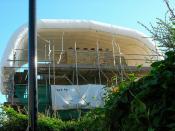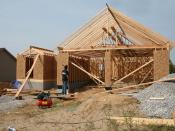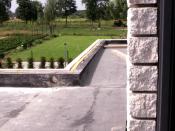3a)ÃÂWeather resistanceRoofs should maintain weather protection to the building to prevent water from entering the building. Roof materials such as clay tiles must overlap each other to prevent rain penetrating between the joints.
ÃÂStrengthThe strength of roofs depends on adequate support from walls, beams and thickness of timber joists. This requirement must comply with BRÃÂs Approved Document A where the roof should not suffer deflection and should carry its own load and any other loads such as wind and snow.
ÃÂFire safetyThe fire safety must comply with BRÃÂs AD B where the roof coverings should resist internal and external fire spread.
ÃÂThermal InsulationRoofs need to be insulated and comply with BRÃÂs Approved Document L, to control heat loss from the building internally.
ÃÂDurabilityThe durability of the roof depends on the ability of the roof covering to prohibit weather and temperature fluctuation and must withstand these weather conditions.
Cold roofThis is when the insulation is fitted above the ceiling between the joists whereby the air temperature will be the same temperature as outside the building and the void above the insulation (usually 50mm gap) must therefore be ventilated to prevent condensation in the cold air space.
Firring pieces would be useful at right angles to the joists to allow the ventilation to reach most of the enclosed roof space. A vapour control layer should be placed on the warm side of the insulation to resist condensation.
Warm roofFor flat roofs this type can be separated into the following two:-Sandwich roofs-Inverted roofsFor both types the insulation is fitted above the deck whereby the temperature of the structure and deck are kept close to the temperature inside the building to prevent changes in outside air temperature and from extremes of heat and cold. Warm roofs do not require a ventilated void, hence why...


